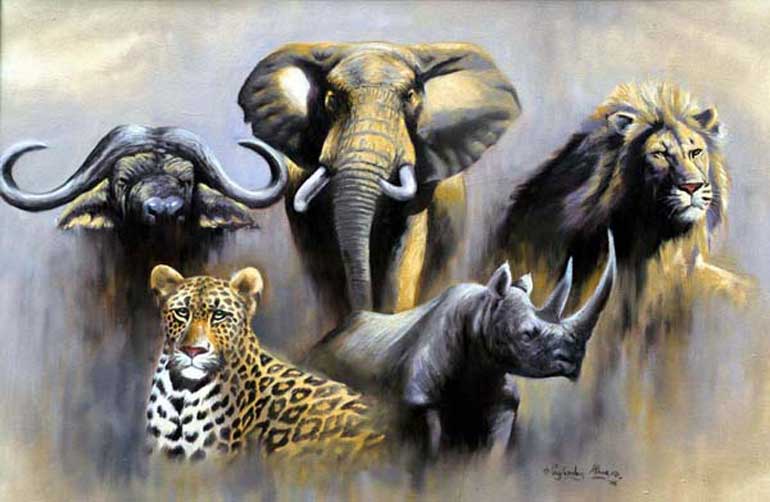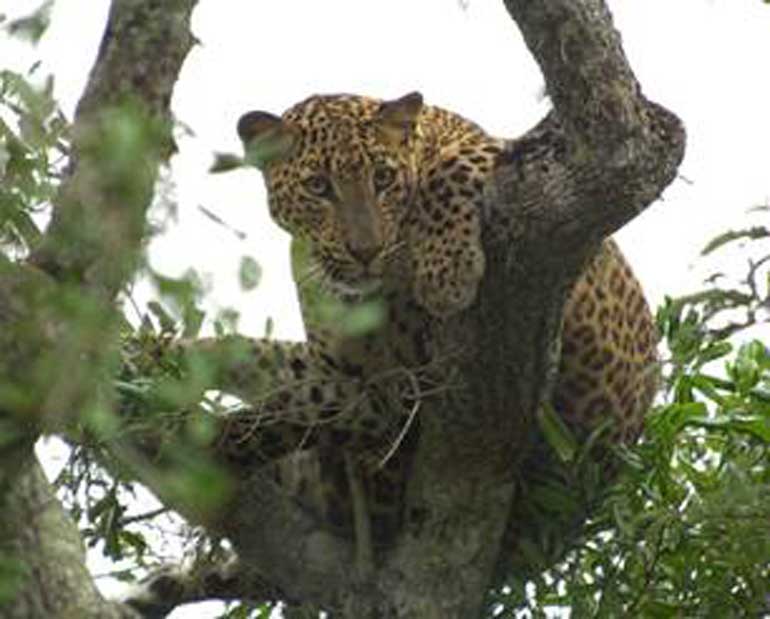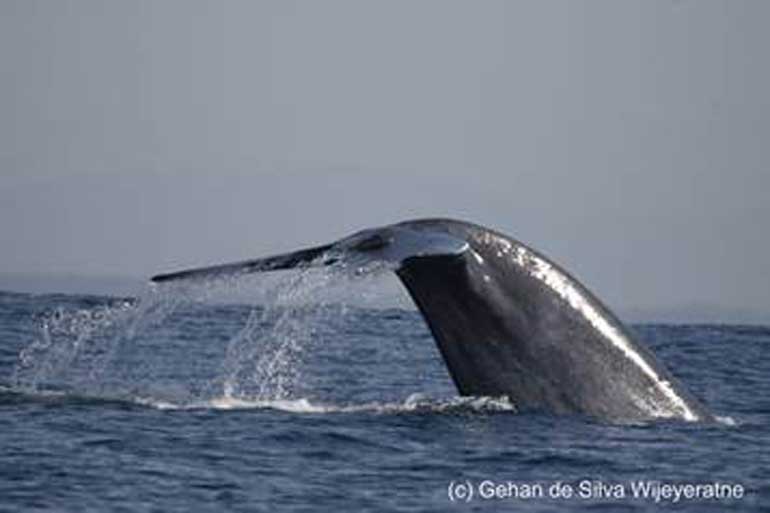Saturday Apr 27, 2024
Saturday Apr 27, 2024
Saturday, 13 February 2016 00:09 - - {{hitsCtrl.values.hits}}

The ‘Big Five of Africa’
By Srilal Miththapala
Recently there were newspaper reports about the Department of Wildlife Conservation (DWC) publicising seven iconic wild animals found in Sri Lanka as a way of promoting tourism. According to this idea, the top seven wild animal species in the list were:
1.Black neck stork
2.Salt water crocodile
3.Elephant
4.Leopard
5.Sloth bear
6.Blue whale
7.Leatherback sea turtle
While certainly, this list contains some rare animals, they are by no means ‘iconic’. The word ‘iconic’ generally refers to widely recognised, well-known and well established things, which have some distinctive excellence and charisma. But in this list, not all of these animals can be referred to as ‘iconic’ (definitely not the black neck stork!).
Of course, there is some logic and sense in embarking on a branding concept for Sri Lanka’s wildlife. Wildlife attractions, which provide value addition to Sri Lanka tourism, certainly help to promote interest in Sri Lanka’s diverse product offering.
Today, the ‘Gathering’ of elephants at Minneriya National Park (during the months of May to September) is must see on the tourism itinerary, and is considered one of the great wildlife wonders of the world (http: http://natgeotv.com/asia/thegreatelephantgathering).
Similarly, whale watching along the coastal area of Kalpitiya and Mirissa are also popular tourism attractions today. The fact that one can see the largest mammal on land, the elephant, and the largest mammal that has ever lived on this earth, the blue whale, in one same place in Sri Lanka, is another unique fact that is now being promoted.
A few weeks ago, two of Sri Lankan wild life parks (Yala and Uda Walawe) were listed among the Top 20 Safaris in the world by ‘Tourist Link’. Hence, it would perhaps be an opportune time for Sri Lanka tourism to popularise and brand wildlife in Sri Lanka.
 The Sri Lankan Elephant – Pic by Srilal Miththapala
The Sri Lankan Elephant – Pic by Srilal Miththapala

Africa’s Big 5
Africa has successfully branded the ‘Big 5’, which comprises five of the most sought after, and sometimes dangerous, aggressive and iconic wild animals, to promote wildlife tourism. A trip to the wildlife parks in Africa is not complete, if all these animals have not been sighted, and most visitors will go to great length to get a glimpse of these animals on their safari. This has given rise to the very popular brand ‘Big Five of Africa’, which is now synonymous with Africa’s wildlife and tourism.
The Big 5 are:
Branding Sri Lanka wildlife
In embarking to create a similar wildlife brand for Sri Lanka, one should first consider some basic marketing principles.
Famous studies on branding and positioning by Al Ries and Jack Trout have indicated that ‘positioning is what you do to get into the mind of the prospect, and to manipulate the wants that are already there in the prospect’s mind’.
Any marketer will tell you that a new brand is very difficult to create and needs effort, focus, time and resources to launch and develop. The brand concept, attributes and positioning have to be carefully thought through and strategically planned out before launching a brand campaign to promote it.
‘Piggybacking’ is a strategy sometimes used by marketers to launch a brand, with minimum effort and create maximum impact, by leveraging the strength of an already existing popular brand. This requires less effort and resources and in a way, by riding the ‘slip-stream’ of the main brand’s positioning, and capitalising on the already prevalent ‘space’ in the prospect’s mind.
Hence, would it not be the wisest, and the most strategically effective process, to follow the Big 5, and brand Sri Lanka as the country where you can see the Big 4?
Sri Lanka’s Big 4
In keeping with the basic concept of choosing animals who are iconic and charismatic species, one can list out the following as Sri Lanka’s Big 4:
These are all large mammals, which have a great appeal to the general public and can create much interest in wildlife. The whole idea is that we will ‘ride’ the top of the mind ‘recall’ of the Big 5, which will help position Sri Lanka’s Big 4 brand, within the same field of perception of the wildlife tourist, and stimulate greater interest to visit the country.
The elephant
The Sri Lankan Elephant is the most popular and abundant of the four (relatively speaking of course!) and is a distinct subspecies from the main land Asian elephants of India and Thailand. Although about 10,000 of these majestic creatures roamed most parts of our island at the turn of the century, only some 4,000 (Santiapillai & Jackson 1990) or closer to 5,000 now live in the wild today.
Its sheer size (it is the largest living land animal today in the world) and gentle demeanour have always made it a much-loved wildlife icon the world over. However, it is today classified as an endangered species (IUCN Red List) with about 150-200 elephants dying each year in Sri Lanka primarily due to ‘Human Elephant Conflict (HEC).
Pocketed herds are found in fragmented habitats today. The major wild life parks all boast elephant populations, with Uda Walawe perhaps having the largest concentration of both resident and transient elephants (Miththapala S 2003 & de Silva. S et al 2008).
Considerable research has been done on Sri Lankan elephants and their behavioural patterns, by the likes of Eisenberg and Rudran in the past, and more recently by Santiapillai, Prithiviraj Fernando and a host of others. Hence there is no shortage of local expertise but what is required is a national focus on the problem.
Of the Big 4 the elephant is the easiest to see, and already there are several established ‘elephant sighting safaris’ available in most of the wild life parks.
Blue whale
Blue whales are the largest animals which have ever lived on earth, growing up to some 33 metres long, and weighing up to some 150-180 metric tons. They feed on krill, a shrimp like marine invertebrate, and need an enormous 3,000-4,000 kgs day.
They live individually or in very small pods or groups and frequently swim in pairs. They can dive for up to an hour, going to a depth of 100 m. Blue whales breathe air at the surface of the water through two blowholes located near the top of the head. Their spectacular blow is a single stream that rises 12-15 m above the surface of the water.
In Sri Lanka, whale watching was first mooted in the 1980s following the documentation of whale sightings (blue whales and sperm whales) in Trincomalee. The award winning film ‘Whales Weep Not’ (James R Donaldson 1985) helped popularise Trincomalee as a whale watching hot spot, but subsequent security restrictions put paid to these initiatives.
Today whale watching has been popularised well and the preferred take off spot today is Mirissa, deep down south. It is believed that while some of the blue whales off Dondra Head/Mirissa could be resident whales, others could be migratory ones crossing over to the Arabian Sea from the Bay of Bengal, during January, and then returning back in April (Anderson. C)
Whales, and particularly dolphins, are also sighted in the Kalpitiya area on the west coast. The frequency as well as the proximity to the shore makes Sri Lanka one of the easiest places in the world to spot blue or sperm whales.
The leopard
Leopards are cosmopolitan animals, having one of the largest geographic distributions of all terrestrial mammals. These adaptable wild cats can also prey on a range of different species. In Sri Lanka, they are the top predators and are found in all types of forests: from thorn scrub and dry deciduous forests, to lowland rain forests and montane forests.
Leopards are large cats on average, weighing of 37-90 kg for males and 28-60 kg for females.
Until 1996 the leopard in Sri Lanka was considered the same as the Indian sub species, but research in 1996 led by Dr. Sriyanie Miththapala resulted in it being classified as a separate sub species.
The mid 1990s saw an increased interest in the island’s top carnivore: Rukshan Jayawardene and Gehan de S. Wijeratne have focused on photographing the leopard in Yala Block I and Jehan Kumara’s and Dr. Ravi Samarasingha’s BBC documentary ‘The Leopards of Yala’ put the leopard on the map so to speak.
While Perera, Kumara and Samarasingha focused on identifying individual leopards, Andrew Kittle and Anjali Watson began to look at the population, behaviour and ecology of leopards in Yala Block I. Kittle and Watson’s study was extended to other parts of the island and showed that leopards were not only in national parks but living at the edge as well as outside protected areas.
 Leopard – Pic by Franklin Silva
Leopard – Pic by Franklin Silva
Sloth bear
The Sri Lankan Sloth Bear is the only species of bear found in Sri Lanka and, like the elephant, is a distinct subspecies, to the Indian species. The wild population is as less as 1,000 in many isolated areas, although it is only classified as ‘vulnerable’ (IUCN Red List). Destruction of dry-zone natural forest is its main threat.
It is found relatively abundantly in the Yala and Wasgomuwa National Park. It was also distributed well in the Wilpattu National Park, where the current status, like in the case of all the animals in Wilpattu, has to be now freshly ascertained after the opening of the park after so many years.
The sloth bear is a shy animal, but can be quite dangerous if confronted. Villagers consider the sloth bear as the most dangerous wild anima in Sri Lanka, and few will disagree. Sloth bears have a poor sense of sight and hearing; thus, encounters with humans while foraging in the wild tend to be unexpected, and so it may sometimes react aggressively.
Their food comprises heavily of termites and insects, larvae of bees, honey, and ants. Sloth bears are not accomplished predators, but may occasionally visit a carcass or scavenge a fresh leopard kill. Bears are especially fond of the sweet fruit of the Palu tree, and will climb trees when they are in fruit, using their powerful claws.
Very little research has been done on Sri Lankan sloth bears. Among some of the main findings from a survey done during one of the few research studies (Ratnayeke. S et al. 2005) was that sloth bear distribution is closely tied to remaining monsoon forests (also called open forest because of the relatively open canopy) of the dry lowlands in the northeast and south eastern parts of the island
The sloth bear will be perhaps the most elusive of the Big 4 and some organised efforts will have to put in place to further popularise the sighting of this very interesting animal on regular game drives in the National Parks.
Conclusion
With Sri Lanka tourism growing rapidly and maturing, it is important that we create new avenues in sustaining this growth.
In this context Sri Lanka’s Big 4 is, therefore, a timely and useful branding initiative to take forward and build upon at this crucial juncture to popularise Sri Lanka’s natural wonders to the world.

Sloth bear – Pic by Franklin Silva
 Blue whale – Pic by Gehan de Silva Wijeyeratne
Blue whale – Pic by Gehan de Silva Wijeyeratne